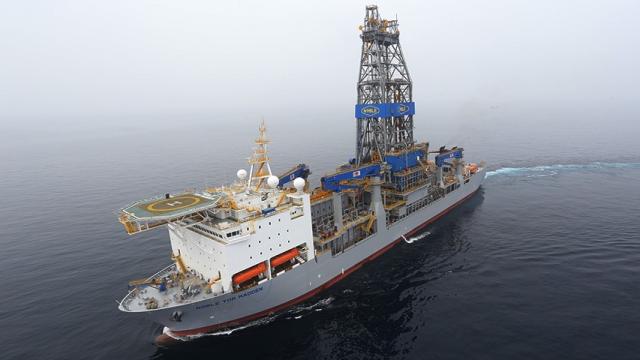
The Noble Tom Madden drillship drilled discovery wells at Exxon Mobil and Hess’ discoveries offshore Guyana in the Stabroek Block. (Source: Hess)
South America offshore oil and gas development is moving into a new age as a result of massive new discoveries—particularly offshore Brazil and Guyana—and falling breakevens that make large-scale developments more financially attractive. The combination of the two has made South America offshore development one of the most attractive plays on the globe.
According to a recent report by GlobalData, the average breakeven oil price for the top 10 upcoming deepwater and ultradeepwater projects in South America is $50/bbl and $40/bbl, respectively. GlobalData reported that more than $81 billion in capex will be spent over the lifetime of the top 10 upcoming offshore projects in South America, which the analyst predicted would eventually produce 8.4 Bboe.
Guyana
At the forefront of the emergence of the South American offshore industry is Guyana, where Exxon Mobil and its partner, Hess Corp., have announced 12 discoveries in the massive Stabroek Block. On Feb. 7, the two companies announced their latest discoveries at Tilapia-1 and Haimara-1 in the southeast portion of Stabroek.
“These two discoveries demonstrate the continuing exploration potential of the prolific Stabroek Block and add to the previously announced gross discovered recoverable resource estimate of more than 5 billion barrels of oil equivalent,” said Hess CEO John Hess in a statement announcing the discoveries.
According to Hess, the previous 10 discoveries on the Stabroek Block established the potential for at least FPSOs to produce more than 750,000 bbl/d by 2025.
Liza Phase 1 opened the play and was sanctioned in 2017. Liza Phase 1 is expected to come online in early 2020 and produce up to 120,000 bbl/d from the Liza Destiny FPSO. Liza Phase 2 will use a second FPSO and is expected to produce up to 220,000 bbl/d after its startup in 2022, according to Hess.
Liza Phase 1 comes with breakeven costs of $35/bbl (Brent) and Liza Phase 2 has a breakeven of $25/bbl, according to the company. In its 2018 investor presentation, Hess cited low rig rates and an improved standardization approach to lowered costs and improved schedules. It also noted that utilizing FPSOs would accelerate first oil for Liza Phase 1 by up to 12 months.
Wood Mackenzie reported in September 2018 that Guyana’s Liza Complex accounts for 15% of all conventional crude found globally since 2015.
Meanwhile, Payara, located 19 km (12 miles) northwest of Liza, might see a sanction later this year with production initiating in 2022.
Other developments in the Stabroek Block include Snoek, Turbot, Pluma, Ranger, Hammerhead, Longtail and Pacora.
Barbara Lowery-Yilmas, senior vice president of exploration for Hess, said during the company’s 2018 investor day that the company plans to continue exploration and appraisal activity this year, particularly southeast of the Turbot area. According to Hess, the Turbot areas includes the Tilapia, Turbot, Longtail and Pluma discoveries.
Hess stated in its announcement of Tilapia-1 and Haimara-1 that the growing Turbot area is expected to progress to a major development hub with baseline 4-D seismic data acquisition underway.
Located north of Stabroek is the emerging Kaieteur Block, located 250 km (155 miles) offshore Guyana. Hess and Exxon Mobil have purchased blocks there or began seismic surveying in some areas. In April 2018, Hess announced it acquired a 15% participating interest in the block. Its 2018 work program there included processing and interpretation of about 5,700 sq km (2,201 sq miles) of 3-D seismic data and evaluation of a future drilling program. According to Hess, the Kaieteur Block lies in the same geologic basin as the Stabroek Block.
Suriname
Adjacent to the prolific Guyana Basin is the Suriname Basin, and the two combined hold an estimated 13.6 Bbbl of oil and 906.1 Bcm (32 Tcf) of natural gas, making the second most prospective offshore oil basin in the world, according to the U.S. Geological Survey.
Among the companies leading exploration work in the Suriname Basin have been Exxon Mobil, Kosmos Energy, Chevron, Tullow Oil and national oil companies Repsol and Equinor.
Speaking during the company’s third-quarter 2018 investor call, Apache CEO John Christmann said the company has identified several high-quality prospects in the region and plans to drill at least one well there this year.
“We will initiate a drilling program [in 2019] on Block 58, where Apache currently owns 100%,” he said. “This block is untested and adjacent to the Exxon Mobil-operated Stabroek Block in neighboring Guyana.”
Some early results in the basin, however, have not been favorable. Kosmos Energy struck out on two wells last year, Pontoenoe-1 in Block 42 and Anapai-1A in Block 45. However, Kosmos saw enough there to continue its exploration efforts into the future.
“We are in the early stages of exploring the emerging Suriname-Guyana Basin, and given the indications of a mature source, quality cretaceous reservoir, and the independent nature of the prospectivity, we believe there is significant remaining potential in Block 42,” said Andrew Inglis, Kosmos chairman and CEO, in an October release. “Our current plan is to test the next prospect in 2020.”
Brazil
As much of Brazil’s famed Campos Basin nears the end of its economic life—Wood Mackenzie estimated in its September 2018 report that 32 platforms would reach their economic cut-off by 2025—the country’s Santos Basin has emerged as its next great producer. The rise of the Santos Basin can be partly attributed to Brazil’s government passing legislation in 2016 that allows greater private and foreign investment in the country’s offshore acreage. The new legislation resulted in licensing activity offshore Brazil to peak in 2017 and 2018, according to a report from Wood Mackenzie.
In a September 2018 auction, Brazil’s government awarded blocks in the presalt layer to Royal Dutch Shell, Exxon Mobil, Chevron and Petrobras.
According to Petrobras, presalt production has steadily increased in the Santos Basin since 2010, reaching more than 1MMbbl/d in 2016 and accounting for more than 50% of Brazil’s oil and gas production. The presalt formation contains about 16.4 Bbbl of crude reserves in Brazil’s ultradeep waters.
“The main challenges that the development of presalt fields face include harsh oceanographic conditions in the Santos and Campos basins—an ultradeep water environment without pre-installed production infrastructure, which is 300 km [186 miles] off the coast with water depths reaching deeper than 2 km [1 mile] and an oil reservoir nestled 5 km [3 miles] below the seabed with a 2-km thick salt layer above,” Stratas Advisors reported in a 2018 report on Brazil offshore production.
Among the solutions to those challenges that Stratas noted were the development of pipeline infrastructure to take oil and gas from the seabed to the platform, new well construction solutions and the design of CO2 separation and reinjection systems that enable oil production in the most extreme presalt reservoirs.
Also supporting increased development has been declining breakeven prices, which fall to about $35/bbl to $40/bbl for new presalt projects, according to BP.
Brazil’s latest projects include Búzios 1, on which Petrobras started production in April 2018. Búzios 2 began production in November from the P-75 platform. According to Petrobras, P-75 was the fourth platform to start production in 2018, after the FPSO Cidade Campos dos Goytacazes in the Tartaruga Verde Field, the P-69 in the Lula Field and the P-74 in the Búzios Field.
Although the Campos Basin might need as much as $8 billion for decommissioning and related infrastructure for the 32 aging platforms, Wood Mackenzie suggested that same sum could be instead invested in the redevelopment of those mature fields, further extending field life and production.
“We estimate redevelopment could add 230,000 bbl/d by 2025 and postpone 60% of the decommissioning costs to post-2030,” the company reported.
Recommended Reading
Hess: Pre-emption Provision Doesn't Apply to Buyout Deal With Chevron
2024-02-27 - Hess Corp. said on Feb. 27 that a pre-emption provision does not apply to its proposed $53-billion buyout by Chevron Corp. and it remains "fully committed" to the deal.
EQT, Equitrans Midstream to Combine in $5.5B Deal: Reports
2024-03-11 - EQT Corp.'s deal would reunite the natural gas E&P with Equitrans Midstream after the two companies separated in 2018.
DXP Enterprises Buys Water Service Company Kappe Associates
2024-02-06 - DXP Enterprise’s purchase of Kappe, a water and wastewater company, adds scale to DXP’s national water management profile.
ARM Energy Sells Minority Stake in Natgas Marketer to Tokyo Gas
2024-02-06 - Tokyo Gas America Ltd. purchased a stake in the new firm, ARM Energy Trading LLC, one of the largest private physical gas marketers in North America.
California Resources Corp., Aera Energy to Combine in $2.1B Merger
2024-02-07 - The announced combination between California Resources and Aera Energy comes one year after Exxon and Shell closed the sale of Aera to a German asset manager for $4 billion.



